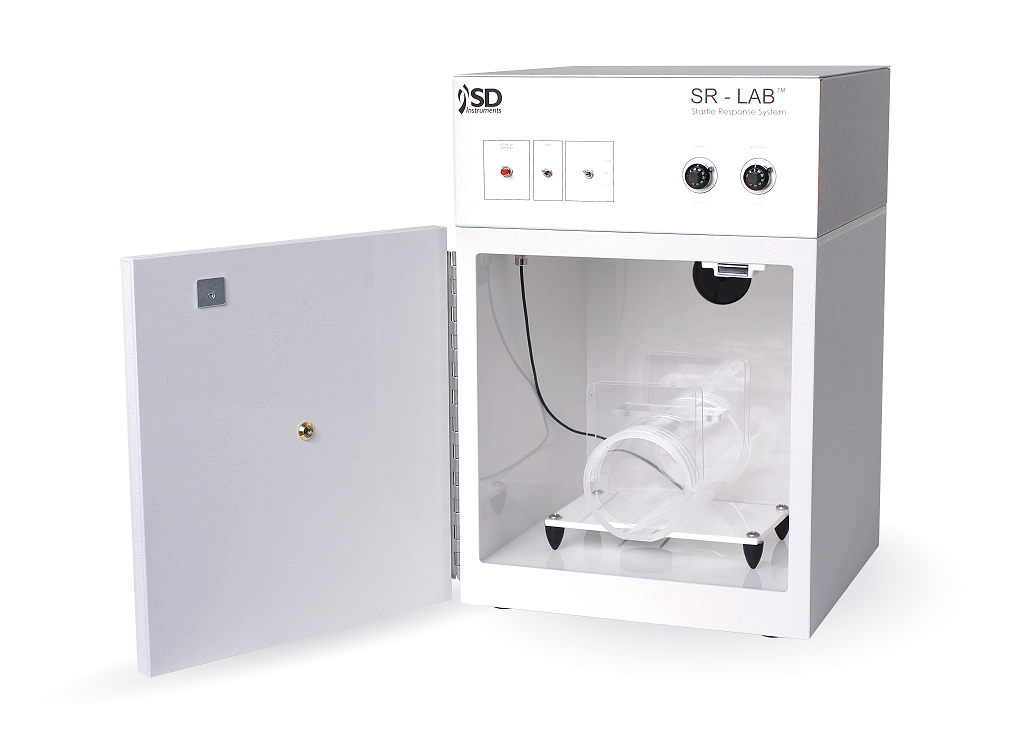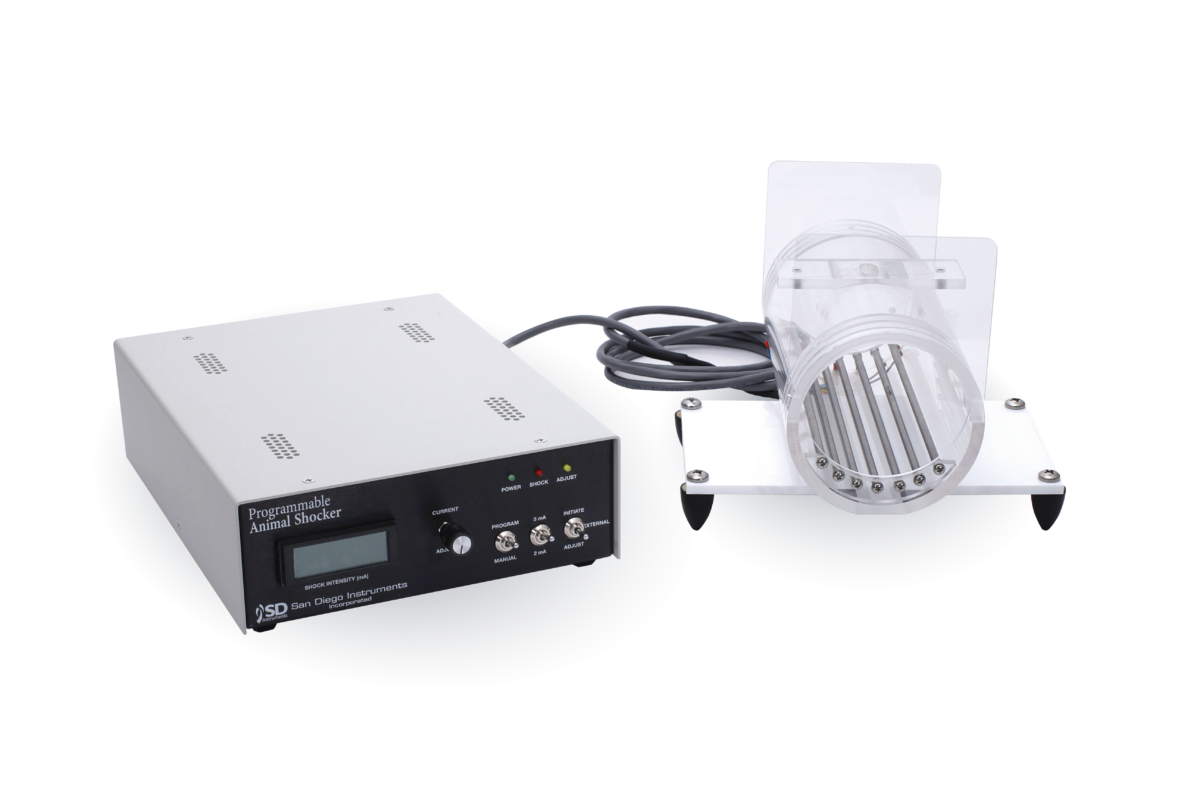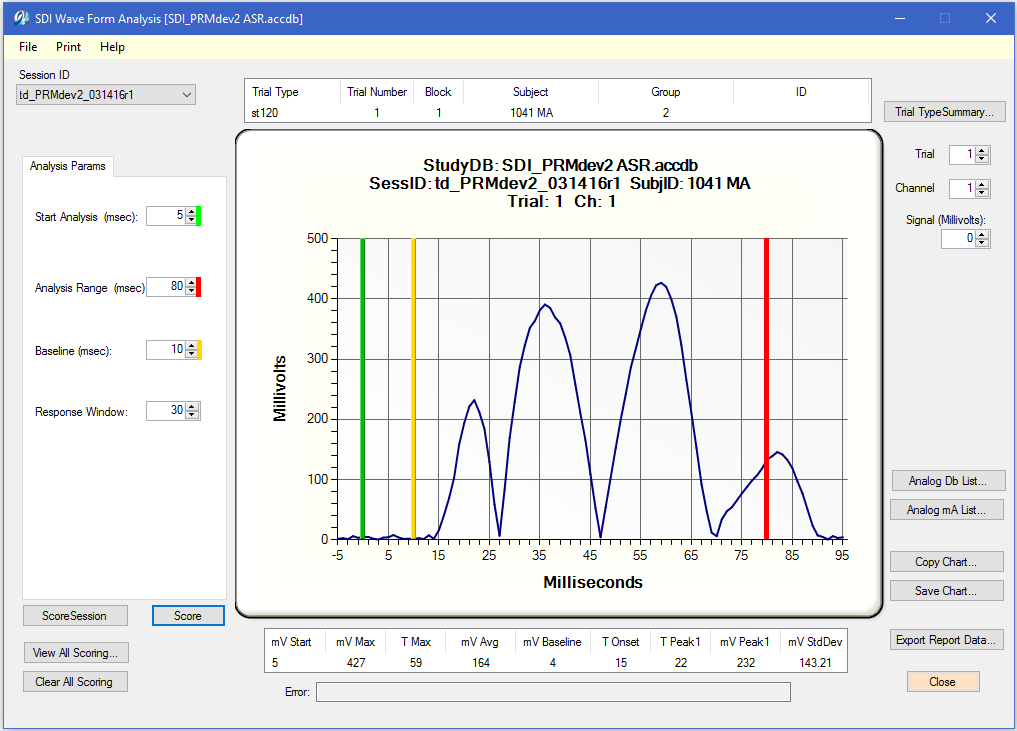SR-LAB-Startle Response System
Startle Response System#
The SR-LAB startle response system is the world’s most widely used startle reflex research system for measuring startle habituation, pre-pulse inhibition (PPI) and Fear Potentiated Startle (FPS).
SR-LAB provides a complete hardware and software solution for a wide variety of startle applications. The system can be configured with up to 16 stations for high through put.
SR-LAB software controls virtually any combination of tones, noise bursts, lights, air puffs, background noise and foot shock options. Importantly, SR-LAB supports multiple test paradigms without requiring costly add-on kits or additional software.

Features#
Supports all startle paradigms including startle habituation, pre-pulse and cross-modal inhibition, fear potentiated startle, trace conditioning and gap detection. Configure up to 16 test stations for rapid testing of large subject groups Easy to use software controls all test paradigms Plug-in kits for shock, puretone, airpuff and light stimuli Results reported millivolts Test animals of varying sizes with five different enclosure options
Description#
Easily Test the Most Prevalent Test Paradigms The basic SR-LAB System will test the Startle Habituation and Pre-Pulse Inhibition paradigms with no additional kits required. To test the Fear Potentiated Startle paradigm, simply add on the SR-LAB Potentiated Startle Kit which includes the SDI Shocker (a proprietary design that keeps the animal from determining any patterns), a shock grid, and a cue light. No additional software is required to support the Fear Potentiated Startle paradigm.
One Software Program for All Paradigms With the SR-LAB software, you can develop and execute any startle reflex testing paradigm. Other systems utilize different software for each paradigm which has two drawbacks: One—you will spend more money, and two—you have no flexibility in designing your own paradigms, and instead are limited to the paradigms offered by the manufacturer.
Be assured all trials are executed without missing any trials using SR-LAB’s concept of a Session containing Trials (discrete tests). Each session will run the animals through all the trials, and save all trial data for later analysis.

Other highlights of SR-LAB™’s software include:#
Construct Trial Definitions with No Programming Required Define your trials to meet your specific needs by selecting commands from a wide range within a predefined menu. Add, Insert or Delete commands to assure that the Trial definition is correct for your needs.
Point and Click to Set Session Level Parameters Set your session level parameters, construct trial lists, and set up Inter-Trial Intervals using SR-LAB’s simple point-and-click interface. Your session parameters can include number of samples, sample rate, background noise level, and repetitions. You can also define and edit sessions with the click of a mouse by inserting or removing Trials. In addition, edit or rename your sessions any time with ease. The ability to automatically randomize durations for Inter Trial Intervals assures that the animal will not discern a pattern that would skew results.
At-a-Glance Test Monitoring Monitor your test process at a glance by viewing response waveforms. Unlike other systems, the waveform visual gives you quick assurance that the calculated numbers are accurate. Verify Data with Ease Using the SR-LAB Analysis Software Verify all of your startle response data with the SR-LAB Analysis Software. For each response, you can review the complete waveform to verify your numeric data. Scoring parameters you can set include Start Analysis, Analysis Range, Baseline and Response Window. The SR-LAB Analysis Software also assures your calculated values are correct by allowing you to see, export, and use your raw data values.
Eliminate Concerns about Inaccurate Readings SR-LAB’s accelerometer is a key factor in the accuracy the system provides. The sensor reacts very quickly to sudden force changes—assuring you get an accurate reading for the smallest mouse to the largest rat. The accuracy provided by the sensor is aided by a complimentary enclosure design, which tightly couples the enclosure with the sensor. Other systems use Load Cells which do not react as well to sudden force changes and also have limited ranges, requiring you to change load cells as animal weights change.
Avoid Stress-Induced Results The SR-LAB’s tubular enclosures are designed to allow the animals to turn around freely without constraint—thus avoiding restraint stress that can alter results. At the same time, the tubular design keeps animals over the sensor for reliable results. Your subjects will be monitored using an ultra-stable, hermetically sealed motion sensor that records a wide range of startle responses. Enclosures are designed with clear acrylic for easy cleaning and are available in five different sizes.

Specifications#
Dimensions
- ABS Isolation Cabinet – 15” (W) x 14” (D) x 18” (H)
- Control Box – 10.25” (W) x 10.25” (D) x 4 3/8” (H)
- Small Animal Enclosure – 3 1⁄2” (L) x 1.1” (ID) Up to ~25g
- Small/Medium Animal Enclosure – 5” (L) x 1 1⁄2” (ID) Up to ~50g
- Medium Animal Enclosure – 6” (L) x 2 1⁄4” (ID) Up to ~150g
- Large Animal Enclosure – 8” (L) x 3 1⁄2” (ID) Up to ~450g
- X-Large Animal Enclosure- 10″ (L) x 5″ (ID) Up to ~800g
- Small/Medium Slotted Animal Enclosure – 5” (L) x 1 1⁄2” (ID)
- Medium Slotted Animal Enclosure – 6” (L) x 2 1⁄4” (ID)
- Large Slotted Animal Enclosure- 8” (L) x 3 1⁄2” (ID)
- X-Large Slotted Animal Enclosure- 10″ (L) x 5″ (ID)
Weight 24 lbs. (Isolation Cabinet), 3 lbs. (Control Box)
Material Composition Isolation Cabinet: ABS plastic, Control Box: Plastic, Animal Enclosure: Acrylic
Accessories#
Use the Startle Paradigm You Need without Constraint If the paradigms you need are not included with SR-LAB’s basic kit, add-on kits are available, requiring no additional software or constraints. Add-on kits offered include:
Potentiated Startle Kit This kit, used for Fear Potentiated Startle testing, includes a shocker with 8 scrambled outputs, shock grid and cue light. The scrambled outputs prevent the animal from discerning a shock pattern assuring excellent results.
Pure Tone Kit The pure tone kit allows the user a full range of frequencies driven by an external function generator and audio amplifier to deliver tones. You control the frequency and duration of sounds via the SR-LAB software. This approach eliminates any sound clicks present in other systems. The external isodynamic tweeter speaker that is mounted in the top of the SR-LAB cabinet can handle up to 50 KHz. The tone is generated by applying an analog voltage level to the function generator which outputs the corresponding sine wave frequency to the audio amplifier for output. This kit is extremely useful for gap detection startle reflex testing.
Tactile Kit The Tactile Kit provides an air puff stimulus, which is generally used as a kinder, gentler alternative to shock.
High Intensity Light Kit The kit supplies an immense amount of bright light within the test station, which brings on anxiety in the animal. The LED lights give off no heat, which can affect the animal. This kit is used for anxiety potentiated startle testing.
Standardization Unit Sets a Standard Baseline Response The baseline response of each of your test stations will be set to the same level prior to testing using the Standardization Unit, which attaches to the top of the animal enclosure and places a repeating fixed force on the sensor. Adjust the response level to the guideline numbers in the user’s manual by turning the Response Adjust dial on the side of the test station. After setting one test station, all you need to do is move the Standardization Unit to the next station and repeat. This assures that results data from multiple tests stations can be compared and your resulting analysis is reliable.

Programmable Shocker
Measurement of Startle Response, Prepulse Inhibition and Habituation The startle response is comprised of a constellation of reflexes elicited by sudden, relatively intense stimuli. The startle reflex is useful for studying fundamental properties of nervous function ranging from neurophysiological and anatomical relationships within...
5-HT1A Receptor Knockout, but not 5-HT1B Receptor Knockout Mice, Show Reduced Startle Reactivity and Footshock-induced Sensitization, as Measured with the Acoustic Startle Response To investigate whether the hyperreactivity to mild environmental and novel stimuli in 5-HT1B receptor knockout (1BKO) mice, as suggested by measures of exploratory, aggressive, and impulsive behaviors, can be extended to phasic stimuli, 1BKO and wildtype mice were tested in acoustic startle...
Startle Responses, Heart Rate, and Temperature in 5-HT1B Receptor Knockout Mice Startle reflexes were measured in four identical startle response systems (SR-LAB, San Diego Instruments), each consisting of a non-restrictive Plexiglas cylinder, mounted on a Plexiglas platform and placed in a ventilated, sound-attenuated chamber...
The Effects of Perinatal AZT Exposure on the Acoustic Startle Response in Adult Rats AZT has become the standard medication to prevent the transmission of the human immunodeficiency virus from mother to fetus...
GABA-A and 5-HT1A receptor agonists block expression of fear-potentiated startle in mice The present experiments characterized the acquisition of fear-potentiated startle and determined the sensitivity of FPS to anxiolytic compounds in DBA/1J mice...
Metabotropic Glutamate Subtype 5 Receptors Modulate Locomotor Activity and Sensorimotor Gating in Rodents Use-dependent N-methyl-D-aspartate receptor (NMDAR) antagonists produce behaviors in human volunteers that resemble schizophrenia and exacerbate those behaviors in schizophrenic patients, suggesting that hypofunction of NMDAR-mediated neuronal circuitry may be involved in the etiology of clinical schizophrenia...

FAQ's#
Q: Why is an empty chamber in the SR-LAB giving us a reading? A: Because, as with any system, there is small amount of electrical and mechanical noise in the system. Empty chamber values should be small (<10 mV). This noise is accounted for in the system calibration so the net test results aren’t affected by the ambient noise in the chamber. Contact SDI if these values are large. ALSO SEE NEXT FAQ.
Q: I standardize my SR chambers but still get widely variable results, why? A: If the variability is among the chambers when you standardize, make sure that your chambers are on a stable, flat surface - seismic isolation of chambers is important. If a rigid counter cannot be used, consider mounting chambers on concrete blocks. If the variability is low in standardization, but is seen in animal data then there may be a sound problem. See the manual for calibrating sound.
Q: Why am I not getting any shock with my SR-LAB? A: Check that all cable connections are correct. If the display is blank the main fuse has failed. If the display shows 0.0 and will not move off this reading the high voltage fuse has failed. A user can remove the top of the shocker to replace either fuse. Extra fuses are stored inside the shocker.
Q: Why am I not getting any readings from my SR-LAB? A: Make sure the power supply to the test station is turned on. Check by turning on the light. Check that the response BNC cable going from the test station to the front of the control box is connected securely.
Q: Why am I not getting a startle response from my mice? A: Your mouse may be of a strain that loses hearing as they age. Check to make sure they can hear. Many researchers find that mice show a better startle response to tactile rather than acoustic startle stimuli.
Q: What is the max number of test stations that can be used with SR-LAB? A: Sixteen stations.
Q: What is the difference between habituation and pre-pulse inhibition testing? A: Refer to Geyer, M.A. and Swerdlow, N. R Measurement of Startle Response, Prepulse Inhibition, and Habituation in Current Protocols in Neuroscience (1998) 8.7.1-8.7.15 .
Q: Why do I need a Standardization Unit? A: The Standardization Unit provides a constant input to the SR-LAB software. This allows each chamber to be adjusted to the same baseline response allowing comparison of test results between test stations.. The Standardization Unit also establishes that test stations are reliable.
Q: Can you explain how to set up test sessions? A: First, construct your Trials using the commands from the software menu. Then, construct a Session Definition to control the Background level, the Recording granularity, the Inter-Trial Intervals and the number of repetitions. Within the Session Definition, insert the Trial names you want to run in the order you want them run. We strongly recommend you refer to Geyer, M.A. and Swerdlow, N. R Measurement of Startle Response, Prepulse Inhibition, and Habituation in Current Protocols in Neuroscience (1998) 8.7.1-8.7.15 for rat testing and Geyer, M. A. and Stephanie C. Dulawa (2003) Assessment of Murine Startle Reactivity, Prepulse Inhibition, and Habituation, Current Protocols in Neuroscience, 8.17.1 - 8.17.15 for mice testing.
Q: Do I need an additional isolation cabinet around the SR-LAB chamber for sound attenuation? A: No